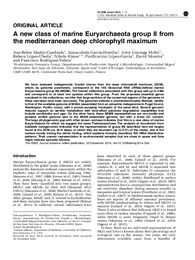Please use this identifier to cite or link to this item:
https://hdl.handle.net/11000/4813
A new class of marine Euryarchaeota group II from the mediterranean deep chlorophyll maximum
Title:
A new class of marine Euryarchaeota group II from the mediterranean deep chlorophyll maximum |
Authors:
Martín Cuadrado, Ana Belén
García Heredia, Inmaculada
Gonzaga Moltó, Aitor
López Úbeda, Rebeca
Kimes, Nikole
López García, Purificación
Moreira, David
Rodríguez Valera, Francisco |
Department:
Departamentos de la UMH::Producción Vegetal y Microbiología |
Issue Date:
2014-12-23 |
URI:
http://hdl.handle.net/11000/4813 |
Abstract:
We have analyzed metagenomic fosmid clones from the deep chlorophyll maximum (DCM),
which, by genomic parameters, correspond to the 16S ribosomal RNA (rRNA)-defined marine
Euryarchaeota group IIB (MGIIB). The fosmid collections associated with this group add up to 4Mb
and correspond to at least two species within this group. From the proposed essential genes
contained in the collections, we infer that large sections of the conserved regions of the genomes of
these microbes have been recovered. The genomes indicate a photoheterotrophic lifestyle, similar
to that of the available genome of MGIIA (assembled from an estuarine metagenome in Puget Sound,
Washington Pacific coast), with a proton-pumping rhodopsin of the same kind. Several genomic
features support an aerobic metabolism with diversified substrate degradation capabilities that
include xenobiotics and agar. On the other hand, these MGIIB representatives are non-motile and
possess similar genome size to the MGIIA-assembled genome, but with a lower GC content.
The large phylogenomic gap with other known archaea indicates that this is a new class of marine
Euryarchaeota for which we suggest the name Thalassoarchaea. The analysis of recruitment from available metagenomes indicates that the representatives of group IIB described here are largely found at the DCM (ca. 50m deep), in which they are abundant (up to 0.5% of the reads), and at the surface mostly during the winter mixing, which explains formerly described 16S rRNA distribution patterns. Their uneven representation in environmental samples that are close in space and time
might indicate sporadic blooms.
|
Knowledge area:
Microbiología |
Type of document:
application/pdf |
Access rights:
info:eu-repo/semantics/openAccess |
DOI:
https://doi.org/10.1038/ismej.2014.249 |
Appears in Collections:
Artículos Producción vegetal y microbiología
|
 ???jsp.display-item.text9???
???jsp.display-item.text9???

.png)
